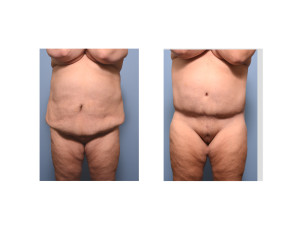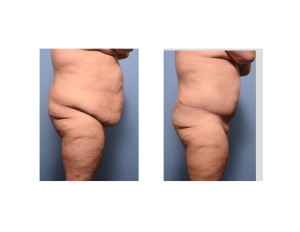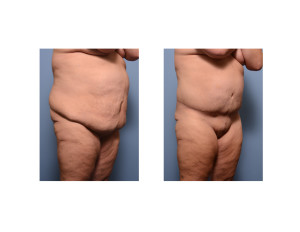Background: There is no more effective procedure in abdominal reshaping than tummy tuck surgery. What separates a tummy tuck from liposuction is that all tissue components of the abdominal fullness are treated as opposed to just fat removal. (liposuction) Tummy tuck surgery can fundamentally be separated into two basic types; normal or close to normal weight women who have abdominal changes from pregnancy and the associated weight gain/loss and originally overweight men and women that have lost some or all of their excess weight. The basic difference between the two is in the amount of residual abdominal skin and fat that remains and whether any other tissue redundancies exist around it.
Large weight loss tummy tucks have to manage a much larger amount of tissue excision. There is usually an abdominal overhang (aka pannus) that extends around the waistline into the back. This problem alone means that the traditional tummy tuck must be extended with longer resultant scars that go into the back. This may or may not solve a vertical tissue excess and this is where the debate of whether the additional scars from a fleur-del-lis tummy tuck is worth it.
One of the common questions in tummy tuck surgery is how much weight needs to be lost before the procedure. In the bariatric surgery patient the amount of weight loss is often maximal due to the bariatric surgery. In the non-bariatric surgery patient, however, patients can still have excess weight but they are frustrated with their pannus and its inability to change. Psychologically they have hit the proverbial wall and are desperate for some positive change. This may prompt them to seek surgery. The surgeon must decide if now is the right now and whether further weight loss is needed.
Case Study: This 44 year old female had lost 55 lbs and came in to be seen for a tummy tuck. Besides her abdominal pannus she still had a fair amount of intraperitoneal fat with a large and firm abdominal bulge above her belly button. She was advised that further weight loss would be better but she wanted to do something now. She was counseled that she would not have a flat abdomen after the surgery and that further liposuction would be needed 3 to 6 months after the tummy tuck to have a better abdominal shaping result.


Highlights:
1) Tummy tuck surgery should follow after one has lost the most weight that they can.
2) Tummy tucks in incomplete weight loss patients should be perceived a excisional procedures to get rid of tissue overhangs rather than producing a sculpted result.
3) Extended tummy tucks are often needed after moderate to large amounts of weight loss to chase the excess tissue around the waistline into the back.
Dr. Barry Eppley
Indianapolis, Indiana



